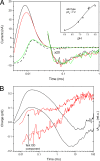A Schiff base connectivity switch in sensory rhodopsin signaling
- PMID: 18852467
- PMCID: PMC2571000
- DOI: 10.1073/pnas.0807486105
A Schiff base connectivity switch in sensory rhodopsin signaling
Abstract
Sensory rhodopsin I (SRI) in Halobacterium salinarum acts as a receptor for single-quantum attractant and two-quantum repellent phototaxis, transmitting light stimuli via its bound transducer HtrI. Signal-inverting mutations in the SRI-HtrI complex reverse the single-quantum response from attractant to repellent. Fast intramolecular charge movements reported here reveal that the unphotolyzed SRI-HtrI complex exists in two conformational states, which differ by their connection of the retinylidene Schiff base in the SRI photoactive site to inner or outer half-channels. In single-quantum photochemical reactions, the conformer with the Schiff base connected to the cytoplasmic (CP) half-channel generates an attractant signal, whereas the conformer with the Schiff base connected to the extracellular (EC) half-channel generates a repellent signal. In the wild-type complex the conformer equilibrium is poised strongly in favor of that with CP-accessible Schiff base. Signal-inverting mutations shift the equilibrium in favor of the EC-accessible Schiff base form, and suppressor mutations shift the equilibrium back toward the CP-accessible Schiff base form, restoring the wild-type phenotype. Our data show that the sign of the behavioral response directly correlates with the state of the connectivity switch, not with the direction of proton movements or changes in acceptor pK(a). These findings identify a shared fundamental process in the mechanisms of transport and signaling by the rhodopsin family. Furthermore, the effects of mutations in the HtrI subunit of the complex on SRI Schiff base connectivity indicate that the two proteins are tightly coupled to form a single unit that undergoes a concerted conformational transition.
Conflict of interest statement
The authors declare no conflict of interest.
Figures






Similar articles
-
Mechanism divergence in microbial rhodopsins.Biochim Biophys Acta. 2014 May;1837(5):546-52. doi: 10.1016/j.bbabio.2013.06.006. Epub 2013 Jul 3. Biochim Biophys Acta. 2014. PMID: 23831552 Free PMC article. Review.
-
Attractant and repellent signaling conformers of sensory rhodopsin-transducer complexes.Biochemistry. 2010 Aug 10;49(31):6696-704. doi: 10.1021/bi100798w. Biochemistry. 2010. PMID: 20590098 Free PMC article.
-
Protonatable residues at the cytoplasmic end of transmembrane helix-2 in the signal transducer HtrI control photochemistry and function of sensory rhodopsin I.Proc Natl Acad Sci U S A. 1996 Jun 25;93(13):6557-61. doi: 10.1073/pnas.93.13.6557. Proc Natl Acad Sci U S A. 1996. PMID: 8692855 Free PMC article.
-
His166 is the Schiff base proton acceptor in attractant phototaxis receptor sensory rhodopsin I.Biochemistry. 2014 Sep 23;53(37):5923-9. doi: 10.1021/bi500831n. Epub 2014 Sep 8. Biochemistry. 2014. PMID: 25162914 Free PMC article.
-
Phototactic and chemotactic signal transduction by transmembrane receptors and transducers in microorganisms.Sensors (Basel). 2010;10(4):4010-39. doi: 10.3390/s100404010. Epub 2010 Apr 20. Sensors (Basel). 2010. PMID: 22319339 Free PMC article. Review.
Cited by
-
Mechanism divergence in microbial rhodopsins.Biochim Biophys Acta. 2014 May;1837(5):546-52. doi: 10.1016/j.bbabio.2013.06.006. Epub 2013 Jul 3. Biochim Biophys Acta. 2014. PMID: 23831552 Free PMC article. Review.
-
A predictive computational model of the kinetic mechanism of stimulus-induced transducer methylation and feedback regulation through CheY in archaeal phototaxis and chemotaxis.BMC Syst Biol. 2010 Mar 18;4:27. doi: 10.1186/1752-0509-4-27. BMC Syst Biol. 2010. PMID: 20298562 Free PMC article.
-
Opposite displacement of helix F in attractant and repellent signaling by sensory rhodopsin-Htr complexes.J Biol Chem. 2011 May 27;286(21):18868-77. doi: 10.1074/jbc.M110.200345. Epub 2011 Mar 29. J Biol Chem. 2011. PMID: 21454480 Free PMC article.
-
Conversion of microbial rhodopsins: insights into functionally essential elements and rational protein engineering.Biophys Rev. 2017 Dec;9(6):861-876. doi: 10.1007/s12551-017-0335-x. Epub 2017 Nov 25. Biophys Rev. 2017. PMID: 29178082 Free PMC article. Review.
-
Sensory rhodopsin-I as a bidirectional switch: opposite conformational changes from the same photoisomerization.Biophys J. 2011 May 4;100(9):2178-83. doi: 10.1016/j.bpj.2011.03.026. Biophys J. 2011. PMID: 21539785 Free PMC article.
References
-
- Ruiz-Gonzalez MX, Marin I. New insights into the evolutionary history of type 1 rhodopsins. J Mol Evol. 2004;58:348–358. - PubMed
-
- Spudich JL, Jung KH. In: Handbook of Photosensory Receptors. Briggs WR, Spudich JL, editors. Weinheim, Germany: Wiley VCH; 2005. pp. 1–21.
-
- Sharma AK, Spudich JL, Doolittle WF. Microbial rhodopsins: Functional versatility and genetic mobility. Trends Microbiol. 2006;14:463–469. - PubMed
-
- Spudich JL. The multitalented microbial sensory rhodopsins. Trends Microbiol. 2006;14:480–487. - PubMed
Publication types
MeSH terms
Substances
Grants and funding
LinkOut - more resources
Full Text Sources
Miscellaneous

